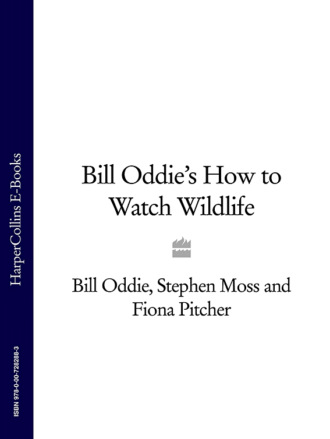
Полная версия
Bill Oddie’s How to Watch Wildlife
B
Keeping a record
If you’re new to watching wildlife, then the very idea of keeping notes or even a diary might seem too much like hard work. If that’s how you feel, then fine. It isn’t compulsory and, if work or family pressures mean that you don’t have all that much time to get out in the field, you might prefer to spend that time watching wildlife rather than writing about it.
On the other hand, taking a few notes of what you see doesn’t take that much extra time and has several advantages:



You might also decide that you want to keep a wildlife diary; something that you write up at home after a day out at a reserve, say, or other trip. Other diaries you can keep can include the wildlife you see in your garden or at your local patch, building up a portrait of the year’s wildlife sightings. Either buy a desk diary (wait until the end of January when they are sold off at half price!), or just use a large notebook and add your own dates.
Write as much or as little as you want. Some people make long, formal lists of species, others simply jot down their memories of the day. This is your diary, so make it something you will treasure when looking back and re-reading it in years to come. Some birdwatchers have notebooks going back more than half a century, enabling them to follow their progress from early childhood to maturity and old age; a tremendously satisfying personal record.
Notebooks and diaries also have another purpose: recording the changes in your local wildlife over periods of time. As you write up your sightings from year to year, this will allow you to notice any changes that occur: such as the first date in spring you saw primroses in the nearby wood, or the last date in autumn there were house martins over your home.
Bill's top tips
_ Writing when outdoors can be difficult, especially if it’s windy or raining, or your hands are beginning to freeze. Some people take notes using a small hand-held tape recorder. It’s much easier, and you don’t have to take your eye off the creature you’re looking at.
_ One of the great joys of keeping notes is that they will bring back memories – hopefully happy ones – of days in the field. You don’t need to add loads of detail, but it is helpful to write down things that will jog your memory. So rather than writing, ‘Barn owl – 1’, why not add something to help you recall the experience, perhaps even years later? You could write, for example, ‘A barn owl flew right past us as we were walking back to the car park – a lovely sight as it went past on silent wings like a ghost’
Such simple records, kept over several decades by amateur wildlife watchers, have proved to be an unexpected asset for scientists investigating the effects of global warming on our wildlife.
Конец ознакомительного фрагмента.
Текст предоставлен ООО «ЛитРес».
Прочитайте эту книгу целиком, купив полную легальную версию на ЛитРес.
Безопасно оплатить книгу можно банковской картой Visa, MasterCard, Maestro, со счета мобильного телефона, с платежного терминала, в салоне МТС или Связной, через PayPal, WebMoney, Яндекс.Деньги, QIWI Кошелек, бонусными картами или другим удобным Вам способом.




